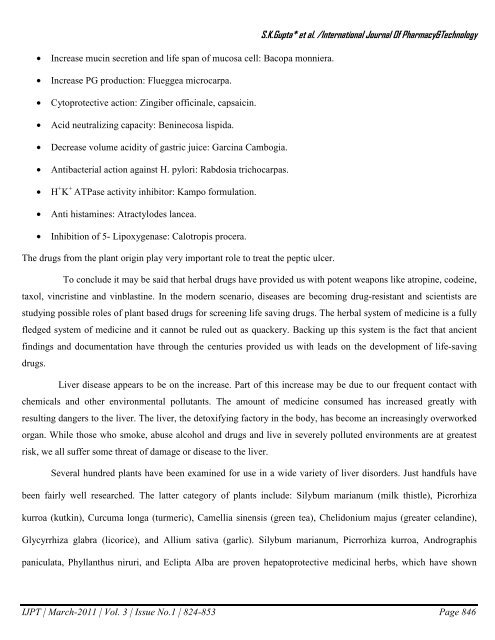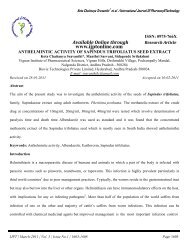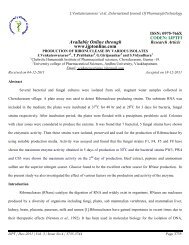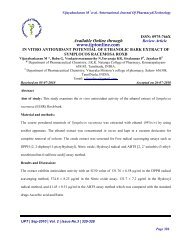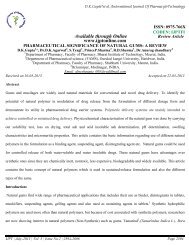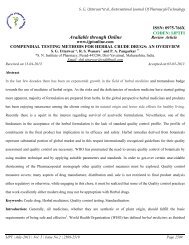SK Gupta* et al. /International Journal Of Pharmacy&Technology
SK Gupta* et al. /International Journal Of Pharmacy&Technology
SK Gupta* et al. /International Journal Of Pharmacy&Technology
- No tags were found...
You also want an ePaper? Increase the reach of your titles
YUMPU automatically turns print PDFs into web optimized ePapers that Google loves.
S.K.<strong>Gupta*</strong> <strong>et</strong> <strong>al</strong>. /Internation<strong>al</strong> Journ<strong>al</strong> <strong>Of</strong> Pharmacy&<strong>Technology</strong>• Increase mucin secr<strong>et</strong>ion and life span of mucosa cell: Bacopa monniera.• Increase PG production: Flueggea microcarpa.• Cytoprotective action: Zingiber officin<strong>al</strong>e, capsaicin.• Acid neutr<strong>al</strong>izing capacity: Beninecosa lispida.• Decrease volume acidity of gastric juice: Garcina Cambogia.• Antibacteri<strong>al</strong> action against H. pylori: Rabdosia trichocarpas.• H + K + ATPase activity inhibitor: Kampo formulation.• Anti histamines: Atractylodes lancea.• Inhibition of 5- Lipoxygenase: C<strong>al</strong>otropis procera.The drugs from the plant origin play very important role to treat the peptic ulcer.To conclude it may be said that herb<strong>al</strong> drugs have provided us with potent weapons like atropine, codeine,taxol, vincristine and vinblastine. In the modern scenario, diseases are becoming drug-resistant and scientists arestudying possible roles of plant based drugs for screening life saving drugs. The herb<strong>al</strong> system of medicine is a fullyfledged system of medicine and it cannot be ruled out as quackery. Backing up this system is the fact that ancientfindings and documentation have through the centuries provided us with leads on the development of life-savingdrugs.Liver disease appears to be on the increase. Part of this increase may be due to our frequent contact withchemic<strong>al</strong>s and other environment<strong>al</strong> pollutants. The amount of medicine consumed has increased greatly withresulting dangers to the liver. The liver, the d<strong>et</strong>oxifying factory in the body, has become an increasingly overworkedorgan. While those who smoke, abuse <strong>al</strong>cohol and drugs and live in severely polluted environments are at greatestrisk, we <strong>al</strong>l suffer some threat of damage or disease to the liver.Sever<strong>al</strong> hundred plants have been examined for use in a wide vari<strong>et</strong>y of liver disorders. Just handfuls havebeen fairly well researched. The latter category of plants include: Silybum marianum (milk thistle), Picrorhizakurroa (kutkin), Curcuma longa (turmeric), Camellia sinensis (green tea), Chelidonium majus (greater celandine),Glycyrrhiza glabra (licorice), and Allium sativa (garlic). Silybum marianum, Picrrorhiza kurroa, Andrographispaniculata, Phyllanthus niruri, and Eclipta Alba are proven hepatoprotective medicin<strong>al</strong> herbs, which have shownIJPT | March-2011 | Vol. 3 | Issue No.1 | 824-853 Page 846


